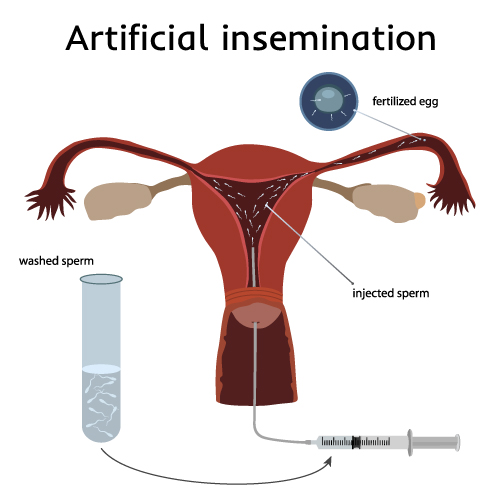Artificial insemination is also known as Intra-Uterine Insemination (IUI) and involves the installation of prepared sperm into the cavity of the womb. For women under 35 years of age, there is a 30-40% chance of having a baby after 3 treatment cycles of IUI.
When is IUI used and when should it not be used?
IUI is often used to treat mild sperm problems and patients with unexplained infertility. It is also used to treat single women and female same-sex couples with donated sperm. Before performing IUI it is important to ensure that the Fallopian tubes are not blocked, or at the very least, that the risk of tubal blockage is low. This is because if tubes are blocked, sperm will not be able to reach the egg to fertilise it and IUI would be useless. IUI is also inappropriate in cases of severe sperm problems; in these cases IVF with ICSI is advised.
Are there different types of IUI treatments?
IUI can be used either in a natural menstrual cycle or one in which drugs are used to induce follicular growth. If drugs are used to induce ovulation in women who otherwise do not ovulate, this is referred to as ovulation induction. Very often, IUI is combined with drugs such as FSH injections in order to cause more than one follicle to develop (usually 2-3 follicles) in women who already ovulate naturally; this is referred to as superovulation. See my sections on Anovulation and Ovulation Induction as well as The Menstrual Cycle and Ovulation Tracking for additional information on follicles and how ovulation comes about.
How is IUI performed?
IUI involves timing when ovulation will occur, sperm preparation and sperm injection.
Timing when ovulation will occur:
In either natural cycles or cycles in which FSH injections are given to induce superovulation, ultrasound monitoring in combination with hormonal blood tests are very important for tracking follicle development in order to precisely time when ovulation will occur. For more information, see my section on The Menstrual Cycle and Ovulation Tracking.
Sperm preparation:
For couples using male partner sperm, the sperm is produced fresh on the day of treatment by ejaculation. This sperm is then prepared in the lab to produce a very small and concentrated volume of the very best quality sperm. If the sperm to be used is frozen donated sperm, this will be thawed on the day of treatment and prepared in a similar way.
Sperm injection:
The IUI procedure is similar to having a Pap smear. The woman’s legs are placed in supports and a speculum is inserted into the vagina to visualise the external opening of the neck of the womb. Using aseptic techniques, the neck of the womb is gently cleaned. The prepared sperm is drawn into a fine tube using a syringe. The tip of the tube is then passed through the neck of the womb and into the upper cavity of the womb. The sperm is then gently expelled from the tube into the womb cavity using the syringe plunger. A pregnancy test is performed about two weeks later to see whether treatment was successful.

